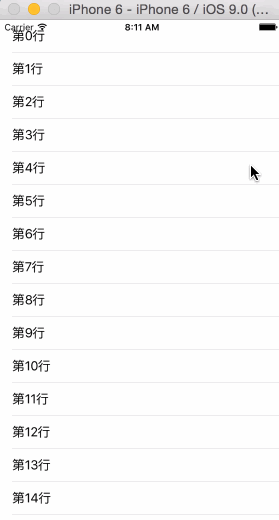本文实例为大家分享了iOS抽屉效果开发实例,供大家参考,具体内容如下
在显示在窗口的控制器上添加三个view(如果只需要往一边滑动就只加2个view)
先声明三个view
#import "ViewController.h" @interface ViewController () @property(nonatomic, weak) UIView *mainV; @property(nonatomic, weak) UIView *leftV; @property(nonatomic, weak) UIView *rightV; @end
添加view到控制器view上
#pragma mark - 添加子控件 - (void)setUpChildViews { UIView *leftV = [[UIView alloc]initWithFrame:self.view.bounds]; leftV.backgroundColor = [UIColor orangeColor]; [self.view addSubview:leftV]; _leftV = leftV; UIView *rightV = [[UIView alloc]initWithFrame:self.view.bounds]; rightV.backgroundColor = [UIColor groupTableViewBackgroundColor]; [self.view addSubview:rightV]; _rightV = rightV; UIView *mainV = [[UIView alloc]initWithFrame:self.view.bounds]; mainV.backgroundColor = [UIColor yellowColor]; [self.view addSubview:mainV]; _mainV = mainV; } - (void)viewDidLoad { [super viewDidLoad]; //添加子控件 [self setUpChildViews]; //添加Pan手势 UIPanGestureRecognizer *pan = [[UIPanGestureRecognizer alloc]initWithTarget:self action:@selector(pan:)]; [self.view addGestureRecognizer:pan]; //添加点按手势,在主视图上任意位置点击回到屏幕开始位置 UITapGestureRecognizer *tap = [[UITapGestureRecognizer alloc]initWithTarget:self action:@selector(tap)]; [self.view addGestureRecognizer:tap]; }
#pragma mark - 手势识别方法 #define targetL -230 #define targetR 200 #define screenW [UIScreen mainScreen].bounds.size.width - (void)pan:(UIPanGestureRecognizer *)pan { //获取手势移动的位置 CGPoint tranP = [pan translationInView:self.view]; //获取x的偏移量 CGFloat offsetX = tranP.x; //修改mainV的frame _mainV.frame = [self frameWithOffsetX:offsetX]; //判断mainV的x是否大于0 [self observeValueForKeyPath:nil ofObject:nil change:nil context:nil]; //复位 [pan setTranslation:CGPointZero inView:self.view]; //判断当手势结束的时候,定位 if (pan.state == UIGestureRecognizerStateEnded) { CGFloat target = 0; if (_mainV.frame.origin.x > screenW * 0.5) { //定位到右边 target = targetR; }else if(CGRectGetMaxX(_mainV.frame) < screenW * 0.5) { //定位到左边 target = targetL; } //获取X轴需要移动的偏移量 CGFloat offsetX = target - _mainV.frame.origin.x; [UIView animateWithDuration:0.25 animations:^{ _mainV.frame = target == 0 ? self.view.bounds : [self frameWithOffsetX:offsetX]; }]; } }
- (void)tap { [UIView animateWithDuration:0.25 animations:^{ _mainV.frame = self.view.bounds; }]; } #define kMaxY 80 #pragma mark - 根据offsetX计算mainV的frame - (CGRect)frameWithOffsetX:(CGFloat)offsetX { //获取上一次的frame CGRect frame = _mainV.frame; //获取屏幕的高度 CGFloat screenH = [UIScreen mainScreen].bounds.size.height; //获取屏幕的宽度 //CGFloat screenW = [UIScreen mainScreen].bounds.size.width; //X轴平移一点对应Y轴需要平移的距离 CGFloat offsetY = offsetX * kMaxY / screenW; //获取上一次的高度 CGFloat preH = frame.size.height; //获取上一次的宽度 CGFloat preW = frame.size.width; //获取当前高度 CGFloat curH = preH - 2 * offsetY; //如果是向左滑动 if(frame.origin.x < 0) { curH = preH + 2 * offsetY; } //获取尺寸的缩放比例 CGFloat scale = curH / preH; //获取当前宽度 CGFloat curW = preW * scale; //获取当前x frame.origin.x += offsetX; //获取当前y CGFloat y = (screenH - curH) / 2; frame.origin.y = y; frame.size.width = curW; frame.size.height = curH; return frame; }
- (void)observeValueForKeyPath:(NSString *)keyPath ofObject:(id)object change:(NSDictionary<NSString *,id> *)change context:(void *)context { if(_mainV.frame.origin.x > 0) {//往右边滑动 _rightV.hidden = YES; }else if(_mainV.frame.origin.x < 0) {//往左边滑动 _rightV.hidden = NO; } }
如果想要在mainV主视图中显示tableView,就新创建一个TableViewController,在这里面显示tableView的数据,
- (NSInteger)tableView:(UITableView *)tableView numberOfRowsInSection:(NSInteger)section { return 30; } - (UITableViewCell *)tableView:(UITableView *)tableView cellForRowAtIndexPath:(NSIndexPath *)indexPath { static NSString *ID = @"cell"; UITableViewCell *cell = [tableView dequeueReusableCellWithIdentifier:ID]; if(cell == nil) { cell = [[UITableViewCell alloc]initWithStyle:UITableViewCellStyleDefault reuseIdentifier:ID]; } cell.textLabel.text = [NSString stringWithFormat:@"第%ld行", indexPath.row]; return cell; }
再创建一个在storyboard中显示的控制器XXMainViewController,继承自实现了抽屉效果的ViewController,并且在storyboard中将class改为这个控制的类名,还要将显示tableView的控制成为他的子控制器
- (void)viewDidLoad { [super viewDidLoad]; XXViewController *vc = [[XXViewController alloc]init]; vc.view.frame = self.view.bounds; //让vc成为主视图控制器的子控制器 [self addChildViewController:vc]; //主视图展示tableView [self.mainV addSubview:vc.view]; }
为了在XXMainViewController中只能访问mainV而不能修改他的值,所以将子控件的view暴露在ViewController.h中,并添加read-only
#import <UIKit/UIKit.h> @interface ViewController : UIViewController @property(nonatomic, weak, readonly) UIView *mainV; @property(nonatomic, weak, readonly) UIView *leftV; @property(nonatomic, weak, readonly) UIView *rightV; @end
运行效果图:

以上就是本文的全部内容,希望对大家学习iOS程序设计有所帮助。
【iOS抽屉效果开发案例分享】相关文章:
